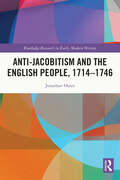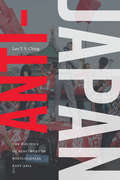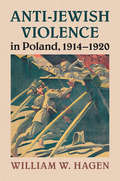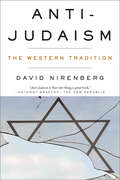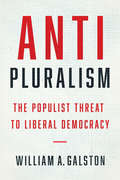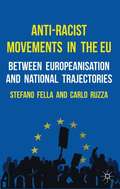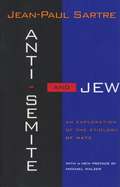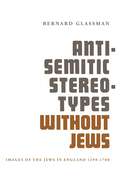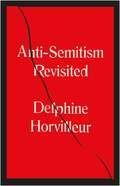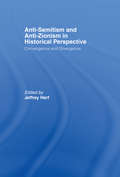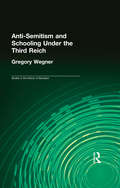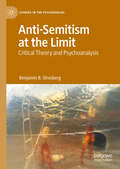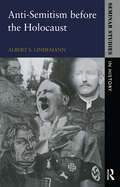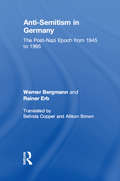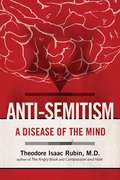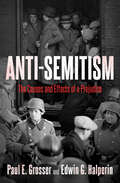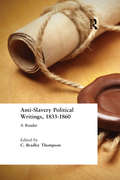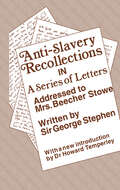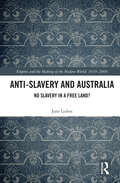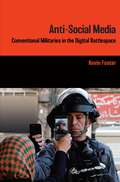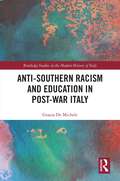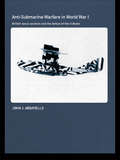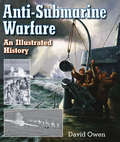- Table View
- List View
Anti-Jacobitism and the English People, 1714–1746 (Routledge Research in Early Modern History)
by Jonathan OatesIn both 1715 and 1745 there was a major military challenge in Britain to the thrones of George I and George II, posed by Jacobite supporters of the exiled Stuart claimant. This book examines the responses of those loyal to the Hanoverian dynasty, whose efforts have been ignored or disparaged compared to the military perspective or that of the Jacobites.These efforts included those of the clergy who gave loyalist sermons, accompanied the volunteer forces against the Jacobites and even stood up to the Jacobite forces in person. The lords lieutenant organized militia and volunteer forces to support the status quo. Official bodies, such as the corporations, parishes, quarter sessions and sheriffs, organized events to celebrate loyalist occasions and dealt with local Jacobite sympathisers. The press, both national and regional, was uniformly loyal. Finally, both the middling and common people acted, often violently, against those thought to be hostile towards the status quo. The effectiveness of these bodies had limits, but was at times decisive, and showed that the dynasty was not without popular support in its hours of crisis.This volume is essential reading for all those interested in the Jacobite rebellions and the early English Georgian state, church and society.
Anti-Japan: The Politics of Sentiment in Postcolonial East Asia
by Leo T. ChingAlthough the Japanese empire rapidly dissolved following the end of World War II, the memories, mourning, and trauma of the nation's imperial exploits continue to haunt Korea, China, and Taiwan. In Anti-Japan Leo T. S. Ching traces the complex dynamics that shape persisting negative attitudes toward Japan throughout East Asia. Drawing on a mix of literature, film, testimonies, and popular culture, Ching shows how anti-Japanism stems from the failed efforts at decolonization and reconciliation, the Cold War and the ongoing U.S. military presence, and shifting geopolitical and economic conditions in the region. At the same time, pro-Japan sentiments in Taiwan reveal a Taiwanese desire to recoup that which was lost after the Japanese empire fell. Anti-Japanism, Ching contends, is less about Japan itself than it is about the real and imagined relationships between it and China, Korea, and Taiwan. Advocating for forms of healing that do not depend on state-based diplomacy, Ching suggests that reconciliation requires that Japan acknowledge and take responsibility for its imperial history.
Anti-Jewish Riots in the Crown of Aragon and the Royal Response, 1391–1392
by Gampel Benjamin R.The most devastating attacks against the Jews of medieval Christian Europe took place during the riots that erupted, in 1391 and 1392, in the lands of Castile and Aragon. For ten horrific months, hundreds if not thousands of Jews were killed, numerous Jewish institutions destroyed, and many Jews forcibly converted to Christianity. Benjamin Gampel explores why the famed convivencia of medieval Iberian society - in which Christians, Muslims and Jews seemingly lived together in relative harmony - was conspicuously absent. Using extensive archival evidence, this critical volume explores the social, religious, political, and economic tensions at play in each affected town. The relationships, biographies and personal dispositions of the royal family are explored to understand why monarchic authority failed to protect the Jews during these violent months. Gampel's extensive study is essential for scholars and graduate students of medieval Iberian and Jewish history.
Anti-Jewish Violence in Poland, 1914–1920
by William W. HagenWidespread anti-Jewish pogroms accompanied the rebirth of Polish statehood out of World War I and Polish–Soviet War. William W. Hagen offers the pogroms' first scholarly account, revealing how they served as brutal stagings by ordinary people of scenarios dramatizing popular anti-Jewish fears and resentments. <P><P>While scholarship on modern anti-Semitism has stressed its ideological inspiration ('print anti-Semitism'), this study shows that anti-Jewish violence by perpetrators among civilians and soldiers expressed magic-infused anxieties and longings for redemption from present threats and suffering ('folk anti-Semitism'). Illustrated with contemporary photographs and constructed from extensive, newly discovered archival sources from three continents, this is an innovative work in east European history. Using extensive first-person testimonies, it reveals gaps - but also correspondences - between popular attitudes and those of the political elite. The pogroms raged against the conscious will of new Poland's governors whilst Christians high and low sometimes sought, even successfully, to block them.<P> The first deeply researched history in any language of Great War era pogroms in Poland.<P> Reconstructs grassroots collective behavior in light of folk culture and social psychology.<P> The multi-lingual research draws on widespread new sources - including archives in Poland, Austria, Israel, and New York City - and myriad first-person testimonies.<P>
Anti-Judaism: The Western Tradition
by David Nirenberg"Exhilarating . . . a scholarly tour de force. The story Nirenberg has to tell is not over."--Adam Kirsch, Tablet This incisive history upends the complacency that confines anti-Judaism to the ideological extremes in the Western tradition. With deep learning and elegance, David Nirenberg shows how foundational anti-Judaism is to the history of the West. Questions of how we are Jewish and, more critically, how and why we are not have been churning within the Western imagination throughout its history. Ancient Egyptians, Greeks, and Romans; Christians and Muslims of every period; even the secularists of modernity have used Judaism in constructing their visions of the world. The thrust of this tradition construes Judaism as an opposition, a danger often from within, to be criticized, attacked, and eliminated. The intersections of these ideas with the world of power--the Roman destruction of the Second Temple, the Spanish Inquisition, the German Holocaust--are well known. The ways of thought underlying these tragedies can be found at the very foundation of Western history.
Anti-Pluralism: The Populist Threat to Liberal Democracy (Politics and Culture)
by William A. GalstonThe Great Recession, institutional dysfunction, a growing divide between urban and rural prospects, and failed efforts to effectively address immigration have paved the way for a populist backlash that disrupts the postwar bargain between political elites and citizens. Whether today’s populism represents a corrective to unfair and obsolete policies or a threat to liberal democracy itself remains up for debate. Yet this much is clear: these challenges indict the triumphalism that accompanied liberal democratic consolidation after the collapse of the Soviet Union. To respond to today’s crisis, good leaders must strive for inclusive economic growth while addressing fraught social and cultural issues, including demographic anxiety, with frank attention. Although reforms may stem the populist tide, liberal democratic life will always leave some citizens unsatisfied. This is a permanent source of vulnerability, but liberal democracy will endure so long as citizens believe it is worth fighting for.
Anti-Racist Movements in the EU
by Stefano Fella Carlo RuzzaSuccessive EU treaties may have instituted a common framework for fighting racial discrimination and intolerance across Europe, but it is a framework that masks the significant differences that arise as a result of national context: for example, pre-existing national anti-racist policies and legislation; the degree of success, character and development of anti-racist movements as well as the political, socio-economic and cultural context in which these policies and movements arise. The aim of this book is to provide an understanding of these different national contexts by exploring the nature of anti-racist movements in six different EU member states and their relationship to political institutions and policy-making, while also reflecting on the impact of the new European sphere of decision-making. Drawing on extensive primary research involving interviews with movement and policy actors at the national and EU level, the book sheds light on the nature of racism and responses to it across Europe, analysing the impact of Europeanisation of policy-making on the sector, and exploring north-south and east-west differences and patterns of convergence.
Anti-Semite and Jew: An Exploration of the Etiology of Hate
by Jean-Paul Sartre George BeckerA classic study from the author of philosophy which is a must-read for any serious student of the aetiology of hatred.
Anti-Semitic Stereotypes without Jews: Images of the Jews in England 1290-1700
by Bernard GlassmanAnti-Semitic Stereotypes Without Jews offers an exploration of English history, 1290- 1700, tracing the growth and development of these attitudes. It demonstrates that it is possible for prejudice to thrive even in the absence of a scapegoat group. Following the expulsion in the year 1290 until 1656, although there was no real Jewish community in England, the molders of public opinion kept a shadowy image of the Jew alive through sermons and religious tracts, travelogues, folklore, religious and secular drama. In his analysis, Dr. Glassman shows that despite their theological differences, Anglican, Puritan, and Catholic clergymen concurred in the negative images of Jews presented to their congregations. They pictured the Jews as Christ-killers, and related myths of how Jews performed barbaric and sacrilegious rituals. The image was to plague Anglo-Jewry after a small community was reestablished in the second half of the 17th century. The author's belief that anti-Semitism is primarily a Christian problem transcends both time and place is covered by this volume. Anti-Semitic sentiments are seen here as reflecting deep-seated, irrational responses to the Jewish people, rooted in the teachings of the church and exploited by men who needed an outlet for religious, social, and economic frustrations.
Anti-Semitism Revisited: How the Rabbis Made Sense of Hatred
by Delphine HorvilleurRabbi Delphine Horvilleur analyses the phenomenon of anti-semitism as it is viewed by those who endure it and who, through narration and literature, succeed in overcoming it. Jewish texts are replete with treatments of anti-semitism, of this endlessly paradoxical hatred, and of the ways in which Jews are perceived by others. But here, the focus is inverted: Anti-Semitism Revisited explores the hatred of Jews as seen through the lens of the sacred texts, rabbinical tradition and Jewish lore. Delphine Horvilleur gives a voice to those who are too often deprived of one, examining resilience in the face of adversity and the legacy of an ancient hatred that is often misunderstood. An engaging, hopeful and very original examination of anti-semitism: what it means, where it comes from, what are the ancient myths and tropes that are weaponised against Jewish people, and how do we take them apart.
Anti-Semitism Revisited: How the Rabbis Made Sense of Hatred
by Delphine Horvilleur"Anti-Semitism revisited in a wholly original way" Philippe Sands"Rippling with ideas on every page" Jewish Chronicle"Tackles the issue [of anti-semitism] from the perspective of a country where its manifestations have been more vicious and deadly" Financial TimesRabbi Delphine Horvilleur analyses the phenomenon of anti-semitism as it is viewed by those who endure it and who, through narration and literature, succeed in overcoming it. Jewish texts are replete with treatments of anti-semitism, of this endlessly paradoxical hatred, and of the ways in which Jews are perceived by others. But here, the focus is inverted: Anti-Semitism Revisited explores the hatred of Jews as seen through the lens of the sacred texts, rabbinical tradition and Jewish lore. Delphine Horvilleur gives a voice to those who are too often deprived of one, examining resilience in the face of adversity and the legacy of an ancient hatred that is often misunderstood. An engaging, hopeful and very original examination of anti-semitism: what it means, where it comes from, what are the ancient myths and tropes that are weaponised against Jewish people, and how do we take them apart.Translated from the French by Ruth Diver
Anti-Semitism and Anti-Zionism in Historical Perspective: Convergence and Divergence
by Jeffrey HerfPreviously published as a special issue of The Journal of Israeli History, this book presents the reflections of historians from Israel, Europe, Canada and the United States concerning the similarities and differences between anti-Zionism and anti-Semitism primarily in Europe and the Middle East. Spanning the past century, the essays explore the continuum of critique from early challenges to Zionism and they offer criteria to ascertain when criticism with particular policies has and has not coalesced into an "ism" of anti-Zionism and anti-Semitism. Including studies of England, France, Germany, Poland, the United States, Iran and Israel, the volume also examines the elements of continuity and break in European traditions of anti-Semitism and anti-Zionism when they diffused to the Arab and Islamic. Essential course reading for students of religious history.
Anti-Semitism and Schooling Under the Third Reich (Studies in the History of Education)
by Gregory WegnerThis book investigates the anti-Semitic foundations of Nazi curricula for elementary schools, with a focus on the subjects of biology, history, and literature. Gregory Paul Wegner argues that any study of Nazi society and its values must probe the education provided by the regime. Schools, according to Wegner, play a major role in advancing ideological justifications for mass murder, and in legitimizing a culture of ethnic and racial hatred. Using a variety of primary sources, Wegner provides a vivid account of the development of Nazi education.
Anti-Semitism at the Limit: Critical Theory and Psychoanalysis (Studies in the Psychosocial)
by Benjamin B. StrosbergIn this book, Benjamin Strosberg explores difficulties and anxieties inherent in studying, defining, and defending against anti-Semitism by tracing a concurrent difficulty in thinking about Jewishness, which has historically served as a limit case for central social categories such as outsider, religion, race, gender, and nation. Dr. Strosberg draws on Zygmunt Bauman’s concept of proteophobia—the anxious fear of what doesn’t fit into clear-cut categories—to think more carefully about anti-Semitism as response to the complex-realities of ambivalence and otherness. The book proposes ‘negative psychology’ as a methodology for studying anti-Semitism and proteophobia rooted in psychoanalysis and Theodor Adorno’s Critical Theory. Drawing from lived experiences, contemporary events, and debates in the field, this compelling work explores the broad implications of the investigation of anti-Semitism for politics, education, and psychoanalysis, as well as the specific implications for Jewish identity and resistance.
Anti-Semitism before the Holocaust (Seminar Studies)
by Albert S. LindemannAn important new study on a complex and highly controversial topic. Albert Lindemann provides a clear and balanced guide to anti-Semitism from ancient times right through to the twentieth-century inter-war period and the Nazi Holocaust. He looks at all countries where anti-Semitism manifested itself at different times and in different ways xxx; in Russia, the US, Poland, England, Germany, South Africa, and Holland. Throughout he asks difficult and unfamiliar questions to challenge long held and misguided beliefs. An important new study which fills a gap in current literature.
Anti-Semitism in Germany: The Post-Nazi Epoch from 1945-95
by Werner Bergmann Rainer ErbThe surrender of Nazi Germany in 1945 marked the end of an epoch during which anti-Semitism escalated into genocide. In the immediate aftermath of World War II, Nazi racist ideology was discredited morally and politically, and the Allied occupation forces prohibited its dissemination in public. However, there was no overnight transformation of individual anti-Semitic attitudes among the public at large. Most surveys conducted since 1946 have confirmed the persistence of massive anti-Semitism in Germany both in the democratic West and the communist East. Based on all empirical survey data available up to now, this volume offers a thorough comparative analysis of anti-Semitism in Germany, and in particular its resurgence with the rise of right-wing extremism since unification.Anti-Semitism in Germany reflects a historically unique opportunity to compare the attitudes of two population groups that shared a common history up to 1945 and then lived under differing political conditions until 1989. The authors find distinct generational patterns in the survival and development of anti-Semitic attitudes. In the Federal Republic hostility towards Jews was more manifest among those who had been socialized to it under the Weimar Republic and Third Reich but less prevalent in subsequent generations. In contrast the authors show younger East Germans as more susceptible to anti-Semitism. The economic and cultural crises of reunification underwrote the strident anti-Zionism of the former communist regime. The authors also explore the anti-Semitic component of the recent wave of xenophobic violence and the disturbing rise of neo-Nazi political activity.This volume is especially noteworthy in its examination of a "secondary" anti-Semitism closely tied to the issue of coming to terms with the Nazi past. The motives behind persisting anti-Semitism can no longer be attributed to ethnic conflict, but go to the core discrepancy between wanting to forget and being reminded. The authors consider this phenomenon within the framework of current German political culture. In its comprehensiveness and methodological sophistication, Anti-Semitism in Germany is a major contribution to the literature on modern anti-Semitism and ethnic prejudice. It will be read by historians, political scientists, sociologists, and Jewish studies specialists.
Anti-Semitism: A Disease of the Mind
by Theodore Isaac RubinA groundbreaking work on the psychodynamics of bigotry and anti-Semitism.As a child, Ted Rubin could not understand why some people hated him and his family only because they were Jews. He soon discovered that other groups were hated and that bigotry was a dangerous disease that destroys its hosts as well as its victims.As a psychiatrist, Dr. Rubin learned that anti-Semitism and other deep-seated prejudices are non-organic diseases of the mind: malignant emotional illnesses that can be treated only by first understanding the unique psychodynamics involved. Little has been written about this aspect of bigotry. Anti-Semitism is a bold endeavor to shed light on one of humankind's most destructive and contagious illnesses, and offers hope and healing for the future.In Anti-Semitism, Rubin lays the groundwork for a person to successfully overcome hatred, to understand where it comes from and why, and to recognize that anti-Semitism devastates people, cripples self-esteem, and is capable of "engendering great suffering, horror and murder." Anyone who has wrestled with hatred or bigotry, either as the victim or the host, will find clarity and direction in Dr. Rubin's eloquent analysis.
Anti-Semitism: The Causes and Effects of a Prejudice
by Paul E Grosser Edwin G. HalperinThis study examines the long history of hatred Jews have endured at the hands of the Catholic Church from ancient Rome to the twentieth century. Anti-Semitism is one of the oldest, most persistent, and most virulent forms of hatred to plague the world. The Holocaust of World War II was the bitter fruit of centuries of prejudice passed down in Christian teachings and perceptions about the Jewish people. In this book, Paul E. Grosser and Edwin G. Haplerin present a historical analysis of anti-Semitism from the Roman Empire, through the Crusades, the Inquisition, the Reformation, and the twentieth century. Through their analysis, Grosser and Halperin reveal a pattern. They shed light on how, where, and when anti-Semitism has spread; how it is temporarily brought under control; and how it suddenly, in some far part of the world, becomes endemic again. The authors provide an illuminating survey of the causes of anti-Semitism and share theories of how the Jews have been able to survive. In conclusion, they offer some hope for the future.
Anti-Slavery Political Writings, 1833-1860: A Reader
by C. Bradley ThompsonThe abolitionist movement in 19th century America led directly to the end of slavery in the United States. This collection of more than 20 original documents including speeches, editorials, books and fiction, captures the deep ideological divisions within the abolitionist movement.
Anti-Slavery Recollection Cb: In a Series of Letters, Addressed to Mrs. Beecher Stowe
by George StephenFirst Published in 1971. When, in the spring of 1853, Harriet Beecher Stowe landed in Liverpool at the beginning of her first triumphal tour of the British Isles, one of the first people she met was Sir George Stephen. It was, in its way, a symbolic encounter. Both were second generation abolitionists whose whole lives had been intimately linked with the progress of the anti-slavery causes in their respective countries. This is a collection of seventeen letters Sir Stephen write to Mrs Beecher Stowe.
Anti-Slavery and Australia: No Slavery in a Free Land? (Empire and the Making of the Modern World, 1650-2000)
by Jane LydonBringing the histories of British anti-slavery and Australian colonization together changes our view of both. This book explores the anti-slavery movement in imperial scope, arguing that colonization in Australasia facilitated emancipation in the Caribbean, even as abolition powerfully shaped the Settler Revolution. The anti-slavery campaign was deeply entwined with the administration of the empire and its diverse peoples, as well as the radical changes demanded by industrialization and rapid social change in Britain. Abolition posed problems to which colonial expansion provided the answer, intimately linking the end of slavery to systematic colonization and Indigenous dispossession. By defining slavery in the Caribbean as the opposite of freedom, a lasting impact of abolition was to relegate other forms of oppression to lesser status, or to deny them. Through the shared concerns of abolitionists, slave-owners, and colonizers, a plastic ideology of ‘free labour’ was embedded within post-emancipation imperialist geopolitics, justifying the proliferation of new forms of unfree labour and defining new racial categories. The celebration of abolition has overshadowed post-emancipation continuities and transformations of slavery that continue to shape the modern world.
Anti-Social Media: Conventional Militaries in the Digital Battlespace
by Kevin FosterOver the past decade the gravitational centre of contemporary conflict has shifted from the physical battlefield to the online battlespace, where the ingenuity of non-state actors has vexed governments and tested their militaries. Devising new architectures of participation, Al Qaeda and ISIS have weaponised social media and empowered their dispersed followers to organise, communicate and dominate the information domain. Kevin Foster shows how conventional militaries in the US, Britain, Israel and Australia have responded to this challenge by integrating social media into their systems and operations, and the organisational and cultural impediments they have confronted. Foster traces each military's social media journey, appraising the strategies, doctrine and policies developed to regulate its management and use. From the ADFA Skype sex scandal to the IDF's sophisticated integration of the real and virtual spaces of war, Anti-Social Media examines the good, the bad and the indifferent in the armed forces' halting advance towards social media competence.
Anti-Southern Racism and Education in Post-War Italy (Routledge Studies in the Modern History of Italy)
by Grazia De MicheleThis book investigates the racism against Southern Italian children attending North-Western primary schools between the 1950s and the 1970s. Turin serves as the main case study, having become the "third Southern city" after Naples and Palermo during the considered period. Far from being a new phenomenon, racism against Southern Italians gained renewed prominence in the context of the post-war mass internal migrations, becoming one of the pillars of the process of nation-rebuilding. However, in spite of its relevance, it has not received the attention it deserves. By drawing on a wide range of sources – printed, archival, photographic and oral – and situating itself at the intersection of history of racism, of education, of psychiatry, and of psychology, the book aims to fill this gap and to add to the debate on the borders that nation-states establish to control the access to power of the different groups inhabiting their territories. Its interdisciplinarity makes it suitable for students and researchers across a variety of subject areas.
Anti-Submarine Warfare in World War I: British Naval Aviation and the Defeat of the U-Boats (Cass Series: Naval Policy and History)
by John AbbatielloInvestigating the employment of British aircraft against German submarines during the final years of the First World War, this new book places anti-submarine campaigns from the air in the wider history of the First World War. The Royal Naval Air Service invested heavily in aircraft of all types—aeroplanes, seaplanes, airships, and kite balloons—in order to counter the German U-boats. Under the Royal Air Force, the air campaign against U-boats continued uninterrupted. Aircraft bombed German U-boat bases in Flanders, conducted area and ‘hunting’ patrols around the coasts of Britain, and escorted merchant convoys to safety. Despite the fact that aircraft acting alone destroyed only one U-boat during the war, the overall contribution of naval aviation to foiling U-boat attacks was significant. Only five merchant vessels succumbed to submarine attack when convoyed by a combined air and surface escort during World War I. This book examines aircraft and weapons technology, aircrew training, and the aircraft production issues that shaped this campaign. Then, a close examination of anti-submarine operations—bombing, patrols, and escort—yields a significantly different judgment from existing interpretations of these operations. This study is the first to take an objective look at the writing and publication of the naval and air official histories as they told the story of naval aviation during the Great War. The author also examines the German view of aircraft effectiveness, through German actions, prisoner interrogations, official histories, and memoirs, to provide a comparative judgment. The conclusion closes with a brief narrative of post-war air anti-submarine developments and a summary of findings. Overall, the author concludes that despite the challenges of organization, training, and production the employment of aircraft against U-boats was largely successful during the Great War. This book will be of interest to historians of naval and air power history, as well as students of World War I and military history in general.
Anti-Submarine Warfare: An Illustrated History
by David OwenA deep dive into the tactics and technology used to defend against submarines—from the opening of the First World War through World War II and beyond. The submarine was undoubtedly the most potent purely naval weapon of the twentieth century. In two world wars, enemy underwater campaigns were very nearly successful in thwarting Allied hopes of victory—indeed, annihilation of Japanese shipping by US Navy submarines is an indicator of what might have been. That the submarine was usually defeated is a hugely important story in naval history, yet this is the first book to treat the subject as a whole in a readable and accessible manner. It concerns individual heroism and devotion to duty, but also ingenuity, technical advances and originality of tactical thought. What developed was an endless battle between forces above and below the surface, where a successful innovation by one side eventually produces a countermeasure by the other in a lethal struggle for supremacy. Development was not a straight line: wrong ideas and assumptions led to defeat and disaster. &“Iconography (with dozens of photographs and often large-format diagrams), a vast bibliography and a complete and documented general approach make this volume a work of great quality and of great interest for all enthusiasts and scholars of this very interesting subject.&”—Storia Militare &“The modeller will not only find the text engaging but there is a superb collection of photographs and illustrations which of course include submarines, corvettes and destroyers. Subjects which the modeller increasingly appreciates. Highly recommended.&”—Model Boats
